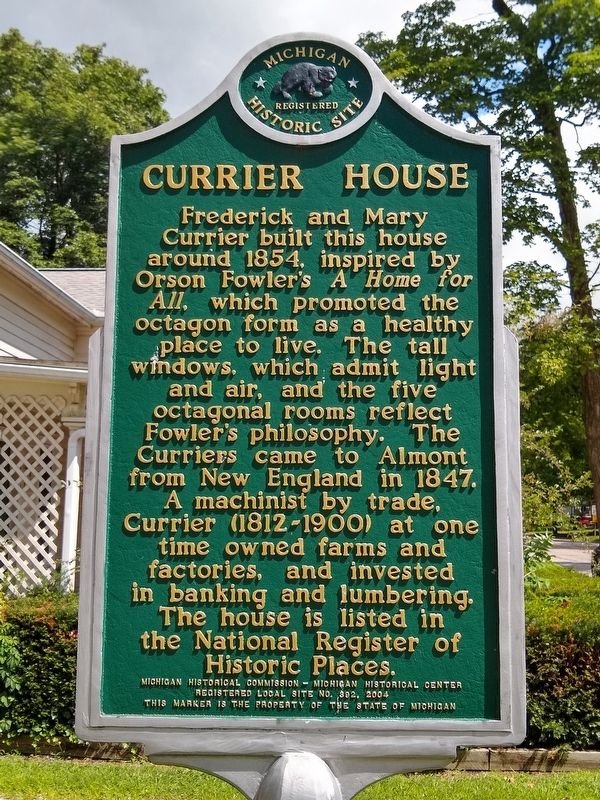Henry Stephens Memorial Library
Albert Stephens offered to fund the construction of a library in honor of his father. The following year local contractor Al Thayer erected this Georgian Revival building.
General Squier Park
General Squier held a great love for his community and showed this by establishing a country club in 1918 for the people of the entire area.
Dryden Depot
Purchased by the Grand Trunk in 1909, the station was used for passenger service until 1955 and as a freight agency until October 9, 1973. It was moved here in 1979 and opened as a museum in 1981.
Currier House
Frederick and Mary Currier built this house around 1854, inspired by Orson Fowler’s A Home for All, which promoted the octagon form as a healthy place to live.
Columbiaville Depot
In the nineteenth century, railroads provided the prime transportation link between small villages and the rest of the country. The first Columbiaville depot was built near this site in 1872.
Water Speed Capital
For more than a century, Algonac has played a leading role in shipbuilding, from sailing cargo ships to large pleasure craft, racing boats, and World War II landing craft.
Wales Township Hall
In 1890, the township board held its first meeting in this Stick Style building. The interior retains the original bench seating around the perimeter of the hall, which is still used for township meetings.
Tunnel Explosion/Lake Huron Water Supply Project
One of the deadliest industrial accidents in Michigan's history, a shotgun-like blast claimed the lives of twenty-two men working on a water intake tunnel beneath the bed of Lake Huron.
Trinity Lutheran Church
This structure, dedicated in 1942, is the third church built on the site. Detroit architect Walter Maul designed the church, and the Detroit Stained Glass Works produced the windows.
Tom Edison at Grand Trunk
In 1859, the railroad’s first year of operation, Tom persuaded the company to let him sell newspapers and confections on the daily trips. He became so successful that he soon placed two newsboys on other Grand Trunk runs to Detroit.
Stewart Farm / Memoir of Aura Stewart
This is likely the oldest farm complex on Harsens Island. In 1849 Aura Stewart purchased 53 acres of the farm and began building this house soon after.
St. Mary's Cemetery
Early church histories state that the cemetery’s earliest burials were the remains of some of the community’s earliest settlers, who had been buried along Anchor Bay but had to be relocated to the cemetery’s southeast corner due to rising water levels.
St. Mary's Church / St. Mary's Rectory
In 1864-65, under the leadership of Father Francis VanderBom, the present brick church was completed at a cost of thirteen thousand dollars. Bricks for the church were hand-formed and hauled to the site by church women.
St. John's United Church of Christ
The original wood-frame structure was erected here in 1869-70 at a cost of five thousand dollars. In 1904 it was enlarged and extensively remodeled to create this Romanesque-inspired structure with its handsome stained glass windows.
St. Clair Inn
In 1925 the local Rotary Club decided that a luxurious establishment was needed to accommodate a large number of tourists and serve as a civic and social center.
St. Andrew's Parish / St. Andrew's Church
The Gothic Revival board-and-batten building stood on the corner of Green and Michigan Streets. This Neo-Gothic structure was dedicated on May 7, 1916.
Shiloh Baptist Church
Though the racial and ethnic composition of South Park has changed over time, the church came to be regarded as the symbolic center of Port Huron’s black population.
Sacred Heart Cemetery
There are more than 150 veterans buried here, including soldiers who served in WWI, WWII, the Korean War, and the Vietnam War.
Port Huron to Mackinac Race/Yacht Club and World War II
The first annual race from Port Huron to Mackinac Island was held on July 25, 1925. 12 boats began the 261-mile race to Mackinac Island, but only six boats finished. After the first Port Huron to Mackinac Race in 1925, entries in the sailing competition increased.
Port Huron Public Library
In 1902 the city of Port Huron secured money from philanthropist Andrew Carnegie to erect a municipal library. Two years later, this grand, Beaux-Arts-style building was completed at a cost of $45,000.



















